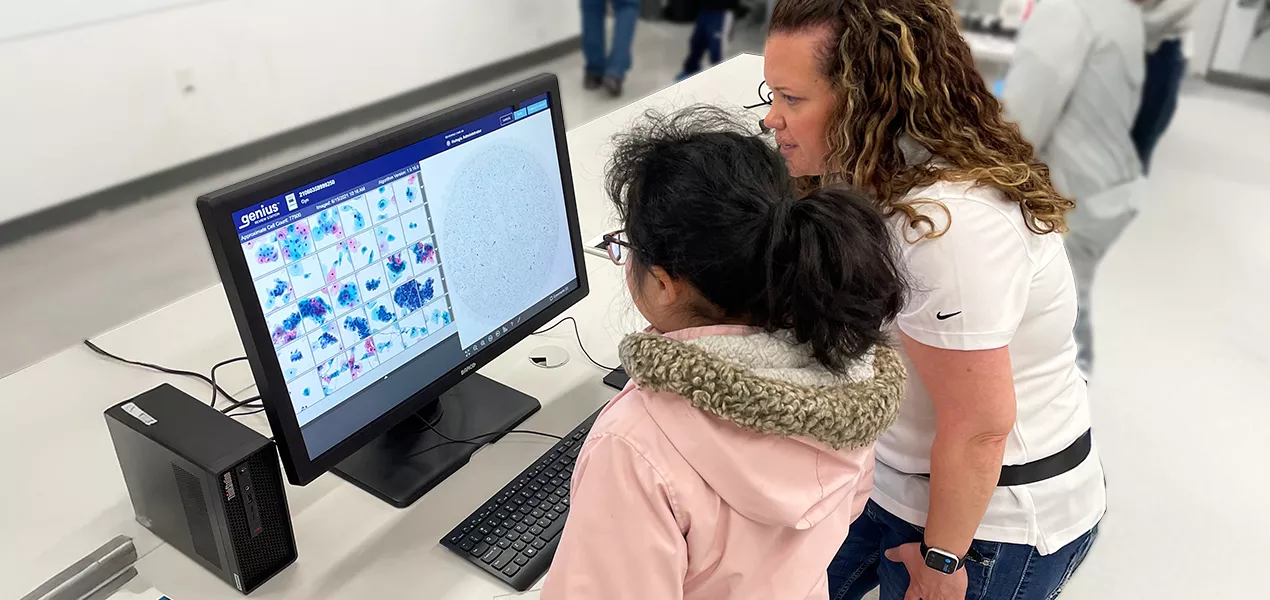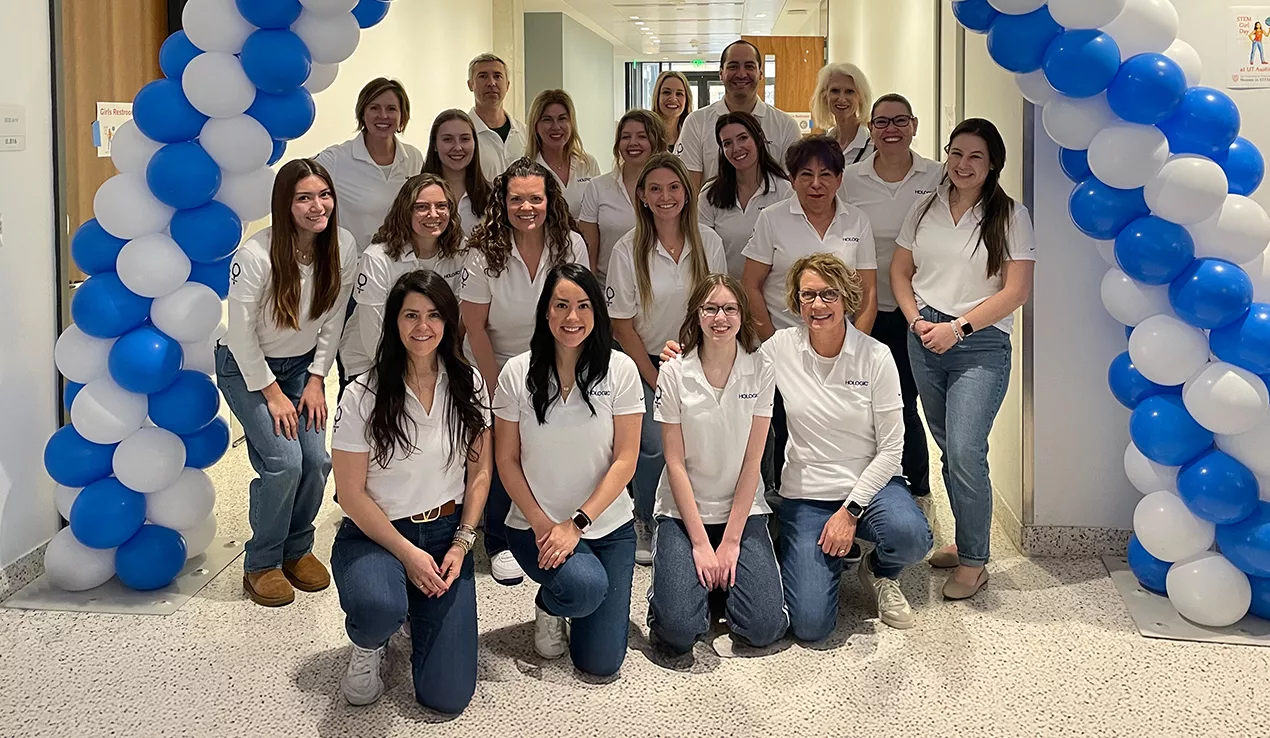Encouraging The Next Generation of STEM Leaders Through Volunteerism

A student experiences firsthand what it’s like to be a cytologist. She is being shown images on Hologic’s Genius™ Digital Diagnostics System, which combines AI with advanced imaging technology to help identify pre-cancerous lesions and cervical cancer cells.
The future of healthcare depends on cultivating a strong workforce of science, technology, engineering and mathematics (STEM) professionals today.
With demand for these skills rising and concerning staffing shortages in critical medical specialties like radiology and cytology, finding new ways to stoke interest in STEM-related careers among young people is more crucial than ever.
Here are some of the ways Hologic employees are giving their time and talents to help students around the country explore the world of STEM.
Real world DNA experiments in California
For more than a decade, Hologic has participated in the San Diego Festival of Science and Engineering, an annual event that brings together technology companies from different industries to educate children and high school students about STEM-related careers. It is hosted by Generation STEAM (with “A” representing the arts), a nonprofit organization that provides opportunities to people in areas where access to resources and education may be limited.

A student gloves up to participate in a blueberry DNA extraction experiment.
At the festival, Hologic volunteers talk with students about what their typical day looks like working at a leading women’s health company. Students can also participate in a hands-on experiment.
This year, some of the older students learned how to extract DNA from blueberries by mixing them with detergent and using alcohol — with the help of adult volunteers — to reveal the DNA strands. After the activity, the students spun a wheel for a prize.
“Before COVID we would have students extract their own DNA,” said Senior Director of R&D Operations Marilyn Vi, who leads Hologic’s participation in the festival each year. “The kids would take their own saliva, mixed with a sports drink, and they’d see how the DNA could be extracted from it. We’d even turn it into a little necklace souvenir for them to go home with.”
Vi and her colleagues in San Diego also participate in other STEM-focused efforts such as the Women Who Inspire conference, where employees share their career journeys and advice with hundreds of local high school students.
A “day in the life” of a cytologist in Texas
Hologic also proudly participates in STEM Girl Day, which draws thousands of K-8th grade students, their families and educators every year. The event, presented by Women in STEM, takes place at the University of Texas (UT) Austin and is the largest program of its kind in the world.
“When I first joined Hologic I brought up the idea of forming a volunteer group to attend STEM Girl Day, and the company was very supportive,” said Michelle Wynn, Director of Market Access at Hologic. “There were discussions then, and even more so now around cytologist shortages, so I thought this could be a way we could help with that.”
At this year’s event, Hologic set up 19 microscopes, giving students a chance to see cells from frog’s blood, and glandular and yeast cells. Participants then looked at cervical cells on a computer screen using the company’s cutting-edge Genius Digital Diagnostics System, the first FDA-cleared AI-powered digital cytology system.
“They were able to see low-grade and high-grade squamous cells showing the progression of cervical cancer, just like a cytologist would, on a computer screen,” said Wynn, adding that the students also learned about the evolution of technology for women’s health, including some of the latest advancements in AI.
“We explained to the kids that instead of looking at cells to find cancer under a microscope, healthcare providers can now view them on a computer screen with AI technology that focuses on areas they need to pay attention to. The kids were really fascinated by that,” said Wynn.

At STEM Girl Day at UT Austin, over 12,000 K-8th grade students engaged in hands-on activities led by STEM enthusiasts, including 20 Hologic volunteers who talked about their careers and some of the latest technologies in women’s health.
According to Wynn, getting students interested in STEM needs to start early. “By the time kids are in high school, often they’ve already chosen a college major and are on their way to choosing a career path,” she said. “STEM Girl Day focuses on elementary and middle school students, so from my perspective you’re reaching these kids at the perfect time.”
Wynn and her team continue to collaborate with the University of Texas and other organizations throughout the year, supporting various programs focused on STEM education.
A first-hand look at how radiologists find breast cancer in Delaware
As part of National Engineers Week, Hologic volunteers in Newark, Delaware took part in an event hosted by Million Women Mentors, a program that brings together partners from throughout the U.S. to support the goal of matching one million girls and women with mentors to boost interest and involvement in STEM-related programs and jobs.
With a theme of “Engineering Your Tomorrow,” nearly 100 middle school girls from 30 different schools gathered at the Conrad Schools of Science for a day of learning, fun hands-on activities and problem-solving.

Hologic volunteers at the Million Women Mentors event in Delaware.
Students learned about many different career paths related to STEM from Hologic employees in roles spanning manufacturing, electrical engineering, quality, physics and many others. A hands-on activity titled, “Are You Smarter Than AI?” gave students a chance to review real mammography images and try to identify suspicious lesions that could be indicative of breast cancer.
“The activity allowed the students to see firsthand what a radiologist does in their daily work, and the difference this real-world application of science and technology can make in the lives of women everywhere,” said Manufacturing Engineer Jothsana Varghese, who volunteered at the event.
“The addition of AI and excitement about the future of innovation in breast cancer detection and care I think made it even more fascinating for them.”
For more information about Hologic’s community impact, including volunteerism, please visit hologic.com/sustainability.
The content in this piece is for informational purposes only and is not intended to be medical advice. Please contact your medical professional for specific advice regarding your health and treatment. This information is not intended as a product solicitation or promotion where such activities are prohibited. Because Hologic materials are distributed through websites, eBroadcasts and tradeshows, it is not always possible to control where such materials appear. For specific information on what products may be available in a particular country, please write to womenshealth@hologic.com.

